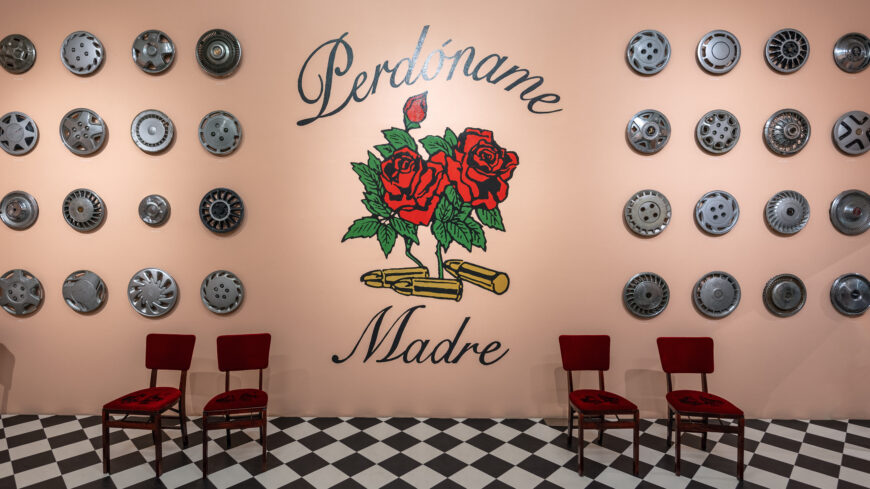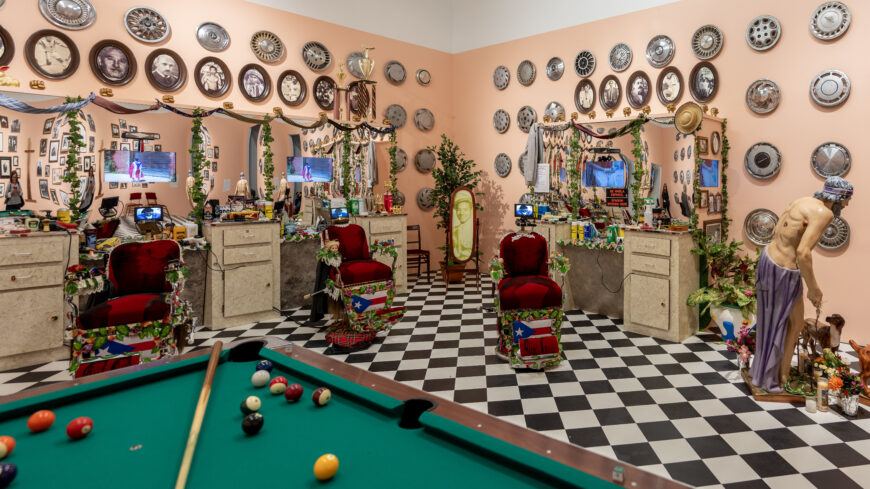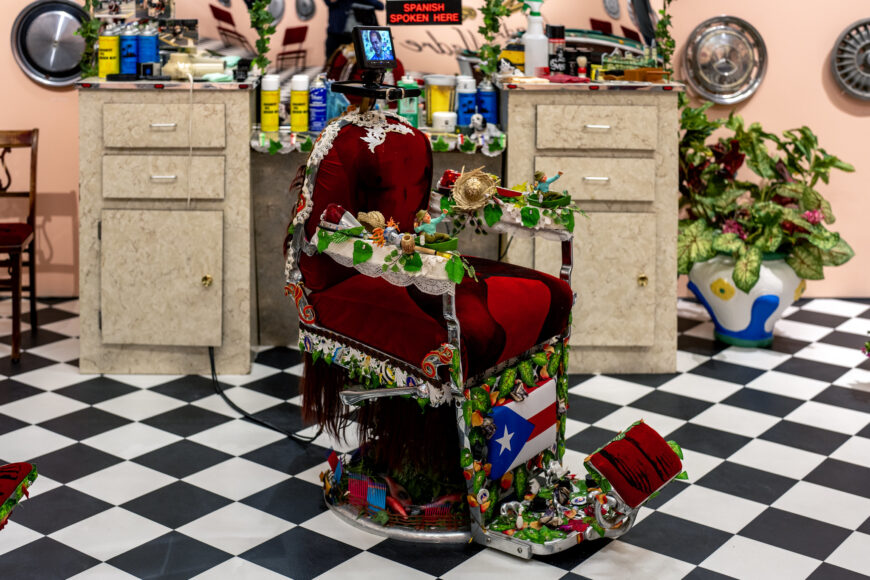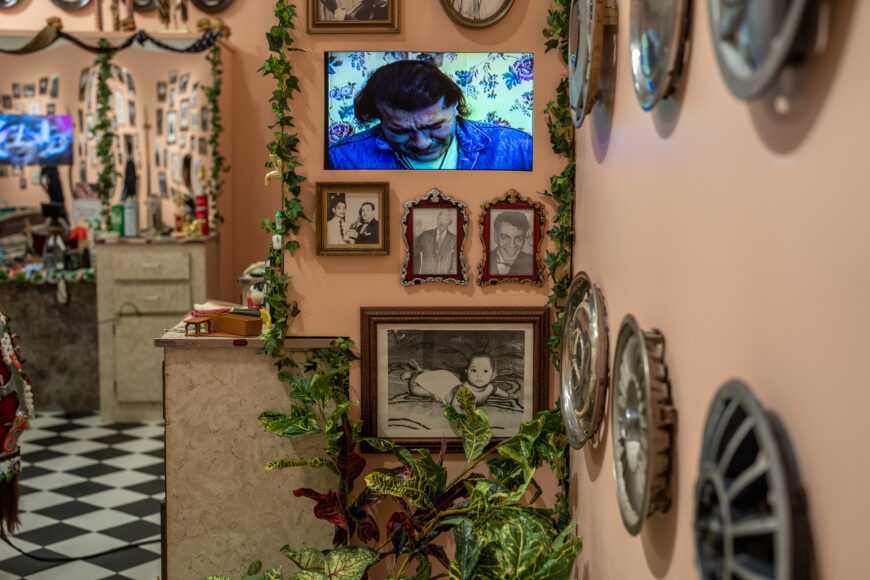Osorio’s art explores the experience of being Puerto Rican in New York City.
Pepón Osorio, En la barbería no se llora (No Crying Allowed in the Barbershop), 1994 (New Museum installation, 2023), mixed media with barber chairs, photographs, objects, and video, variable dimensions (Museo de Arte de Puerto Rico, San Juan) © Pepón Osorio. Speakers: Dr. Tamara Díaz Calcaño and Dr. Lauren Kilroy-Ewbank
The Puerto Rico born artist Pepón Osorio trained as a sociologist and became a social worker in the South Bronx. His work is inspired by each of these experiences and is rooted in the spaces, experiences, and people of American Latino culture, particularly Nuyorican communities. Osorio’s large-scale installations are meant for a local audience, yet they have also been exhibited in mainstream cultural institutions (though after the 1993 Whitney Biennial, Osorio vowed to show his work first within the community, and then elsewhere).

Pepón Osorio, No Crying Allowed in the Barbershop (En la barbería no se llora), 1994 (New Museum installation, 2023), mixed media with barber chairs, photographs, objects, and video, variable dimensions (Museo de Arte de Puerto Rico, San Juan; photo: Steven Zucker, CC BY-NC-SA 2.0) © Pepón Osorio
Nuyorican
Puerto Rico is a United States territory. Its residents are United States citizens and carry an American passport, yet they cannot vote in presidential elections or have representatives voting for their interests in Washington, D.C. This sense of marginality is further complicated when one considers that Nuyoricans often retain a distinct sense of cultural pride that is informed by their dual American and Puerto Rican identities.
Having lived both experiences—that of a Puerto Rican and Nuyorican—Osorio is best known for large-scale installations that address street life, cultural clashes, and the rites of passage experienced by Puerto Ricans in the United States. Outside the traditional museum setting, and commissioned by Real Art Ways (RAW) from Hartford, Connecticut, En la barbería no se llora (No Crying Allowed in the Babershop) is a mixed-media installation first exhibited in the Puerto Rican community of Park Street in Hartford. Created in collaboration with local residents, Osorio engaged the public through conversation, workshops, and artistic collaborations. The art itself is visually lavish—his installations have often been dubbed “Nuyorican Baroque” (a reference to the 17th-century style characterized by theatricality and opulence and found in both Europe and Latin America).

Pepón Osorio, No Crying Allowed in the Barbershop (En la barbería no se llora), 1994 (New Museum installation, 2023), mixed media with barber chairs, photographs, objects, and video, variable dimensions (Museo de Arte de Puerto Rico, San Juan; photo: Steven Zucker, CC BY-NC-SA 2.0) © Pepón Osorio
Masculinity
Inspired from his first haircut in Santurce, Puerto Rico, Osorio recreates the space of the barbershop as one that is intensely packed with “masculine” symbols like barber chairs, car seats, sports paraphernalia, depictions of sperm and a boy’s circumcision, phallic symbols, and male action figurines. Osorio boldly challenges the idea of masculinity, and particularly of machismo, in Latino communities.

Barber chair with chucherías, Pepón Osorio, No Crying Allowed in the Barbershop (En la barbería no se llora), 1994 (New Museum installation, 2023), mixed media with barber chairs, photographs, objects, and video, variable dimensions (Museo de Arte de Puerto Rico, San Juan; photo: Steven Zucker, CC BY-NC-SA 2.0) © Pepón Osorio
Chucherías
Spanish for trinkets or knick-knacks, and known to art historians as kitsch, chucherías overpopulate Osorio’s work. These include Puerto Rican flags, religious ornaments, plastic toys, dolls, ribbons, beads, etc., all of which function—to quote art historian Anna Indych-López—as a “gesture of cultural resistance,” presented as something universal yet personal. [1] The chucherías included in the installation En la barbería no se llora, (a flag, fake foliage, baseballs, framed portraits of famous Latin American and Latino men), serve to localize the work, yet these objects also raise issues of social class expressed here through taste, and the distinction between high and low art—effectively straddling a fine line between cultural celebration and social critique.

Pepón Osorio, No Crying Allowed in the Barbershop (En la barbería no se llora), 1994 (New Museum installation, 2023), mixed media with barber chairs, photographs, objects, and video, variable dimensions (Museo de Arte de Puerto Rico, San Juan; photo: Steven Zucker, CC BY-NC-SA 2.0) © Pepón Osorio
Video
One prominent aspect of En la barbería no se llora are the video installations featuring Latino men from Park Street in stereotypically “masculine” poses. The men vary in age. Osorio included older men from the retirement home, Casa del Elderly, presenting the issue of machismo as multi-generational and deeply ingrained in Nuyorican culture. As a foil to this construction, the artist also included videos of men crying, with the public reacting both in sympathy and disgust.
These same men then participated in workshops, in which they discussed how notions of masculinity had shaped their personal relationships as brothers, husbands, and fathers. Despite this participation of men, most of the visitors to the barbershop installation were, in fact, women. [2]
While En la barbería no se llora (No Crying Allowed in the Babershop) challenges definitions of masculinity, it also brings up—in a more subtle way—the relationship between machismo and homophobia, violence, and infidelity, and the ways in which popular culture, religion, and politics help craft these identities and issues.




